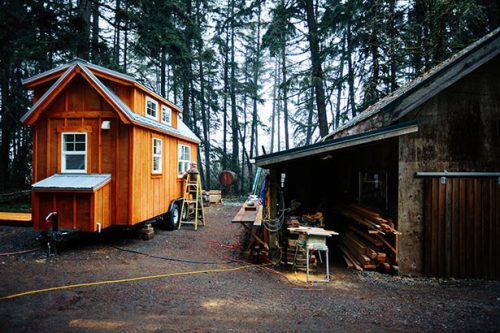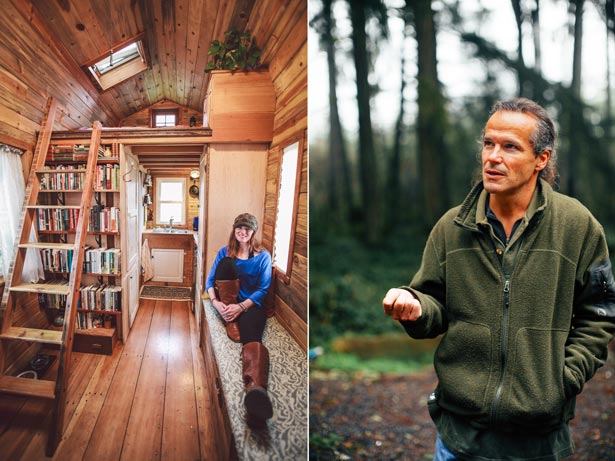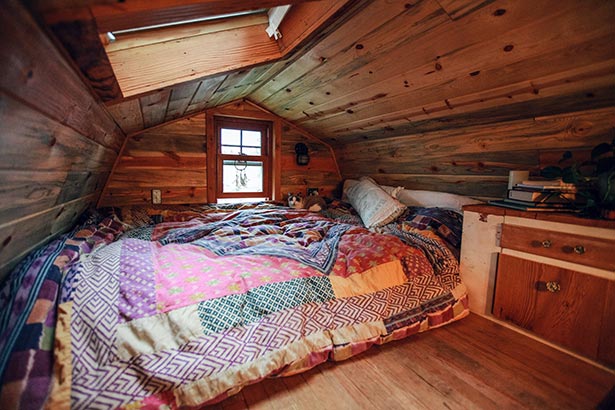
Much of Eugene is proud of Opportunity Village, the self-governing community of formerly homeless people living in tiny homes. But these people are only one aspect of the tiny house movement, a nationwide trend of people eschewing big abodes for simpler living with a smaller carbon footprint.
It’s hard to gauge the number of people living in tiny homes in the U.S. According to The Tiny House Film blog, some people stay under the radar to avoid getting booted off a property due to zoning, while others just don’t make a big deal of their little lifestyle. Some tiny houses on wheels are clumsily categorized as RVs, even though their owners say they’re functionally and aesthetically much more like houses.
But if social media is any indication — the Tiny House Design Facebook page has more than 183,000 likes, and the number of small living Pinterest boards is staggering — our culture is intrigued by small living.
Greener living
Some of the fascination for tiny homes comes from the idea that a small life is a greener life. Downsizing is responsible for much of the energy savings in tiny homes, according to architect Todd Miller. Miller owns Oregon Cottage Company, which builds four customizable models of tiny homes on wheels at its 27-acre site just outside of Eugene. He says a lot of his customers are women in their 60s who have already lived in large homes and are ready for a change.
Using less of a particular material means more customers can afford supplies like recycled paperstone countertops, plywood with glue alternatives and formaldehyde-free EcoBatt insulation, Miller says. “We have a lot of people who have CSD (chemical sensitivity disorder) that come to us because they can control their environment and use a better quality product in their houses because there’s less of it,” he says.
Once the homes are built, Miller says electricity bills can dip as low as $10 per month; his homes cost $30,000-$39,000. Some people rent out their full-size homes to pay off a tiny house.
Energy savings aren’t limited to professionally built tiny homes. April Anson, a UO graduate student, built the first tiny house she’d ever stepped foot in, collaborating with friends and family to construct her 144-sq. ft. movable tiny home in the summer of 2012.
Anson says her home would be greener if her $15,000 budget included solar panels, but the cottage on wheels is wired with AC/DC in case she can afford them in the future. “I do think the rhetoric of the tiny house movement as a method of becoming more sustainable has been slightly inflated, in my opinion,” she says.
Tiny houses can make lives greener by forcing people to confront materialism due to limited storage and the limits of plugging into the grid, Anson says. Charging a laptop, using an electric kettle and making toast maxes out her power.
“It’s tough to see tiny houses marketed as a sort of ‘answer to everything,’” Anson says. “Actually it just promises a deeper engagement and confrontation with all of those things, which I think is the most useful thing about it.”
 |
|
Left: April Anson in her DIY tiny house. Photo by Todd Cooper. Right: Todd Miller of Oregon Cottage Company. Photo by Trask Bedortha.
|
Design
Feedback from customers has led to the evolution of his designs, Miller says. Six years after his tiny house building began, he’s including features like ladders secured with wooden notches, optional French doors, washers and dryers and sleeping lofts that feel big enough to gather with five or six people thanks to the addition of dormers.
“Our suppliers are actually changing their designs, which really helps us because we can adapt our kitchen design to accommodate their appliances,” Miller says. Oregon Cottage Company’s kitchens feature a stacked design in which each space has multiple functions, meaning two people can work in the small space without backing into one another.
Anson says there’s a lot she’d change if she were to build another house — she’d like a compost toilet, less built-in furniture and more food storage — but she’s thrilled with the metal roof that didn’t dent during the recent ice storm, the high ceilings and the closet that’s absolutely packed with clothing, which might be the crown jewel for the first-time builder. Anson says that clothing, much of it thoughtfully thrifted, was the hardest thing to give up when moving into her tiny home.
“I thought it was going to be sort of a giant release to sell everything I own — I’ve never been much of a keeper anyway, but it was surprisingly hard,” she says. “It wasn’t really immediate; it was a much more prolonged orientation from living in a small space and how you move in the space to not being able to buy things or having a different relationship with what I buy.”
 |
|
April Anson’s loft. Photo by Todd Cooper.
|
Romanticization
Even after an adjustment period, Anson says that not everything about tiny house living is easy. “The rhetoric — and I think it’s slowly changing — is pretty romanticized,” she says. Not picking up little treasures that she finds while thrift shopping can still be disappointing for her, and she still keeps books in storage at her mom’s house.
Another challenge is finding a legal place to park. Anson is living in her grandmother’s backyard while she finishes her Ph.D., but not everyone has that option.
An association that Miller works with is trying to find and perpetuate an example of land use codes that work for tiny homes. “We’re finding that we’re going to have to reclassify what a tiny house is,” he explains. “It’s different than an RV because of the way we build them, the way they look and they’re not being taken on the road all the time. They’re usually taken to a certain place and stay there for a while.”
In the meantime, there are slim parking options for tiny homes that are technically RVs. “They are finding that the places that they can put them are a little less desirable: RV parks,” Miller says. “They’re not near walkable areas near the facilities they might want.”
Despite the trade-offs, Miller says, many tiny house dwellers do feel that a tiny home can be freeing. “They’re willing to give up some of the luxuries of a larger kitchen to downsize and to have the freedom to spend with their friends and family and spend a lot less on their housing and the bills they’re paying every month,” he says.
Even with the romanticization of tiny homes, Anson still believes in small living. “I think if the movement can woo people in, the political work of the movement actually comes in the reality of living in one and realizing the degree to which we, including me, have taken stuff for granted.”